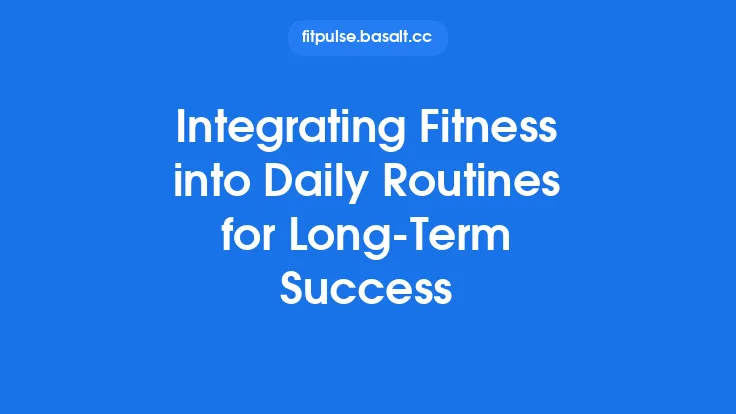Building a lasting family fitness habit isn’t about a single‑off sprint or a perfectly choreographed workout schedule. It’s about weaving movement, mindset, and mutual support into the everyday fabric of family life so that staying active becomes as natural as sharing a meal or watching a favorite TV show together. Below are evidence‑based strategies that help families create, nurture, and sustain a fitness culture that can thrive across generations and adapt to life’s inevitable changes.
Understanding the Psychology of Habit Formation
Research on habit formation consistently points to a three‑part loop: cue → routine → reward. The cue (or trigger) prompts the brain to initiate a behavior; the routine is the behavior itself; the reward reinforces the neural pathway, making the loop stronger over time. For families, the cue can be as simple as “after dinner” or “when the kids finish homework.” The routine is the shared activity—whether it’s a brisk walk, a quick stretch, or a playful movement break. The reward isn’t necessarily a tangible treat; it can be the sense of togetherness, a burst of endorphins, or the satisfaction of checking a habit tracker.
Understanding this loop helps families deliberately design triggers that are easy to notice and routines that are realistic for all members, thereby accelerating the transition from conscious effort to automatic habit.
Creating Shared Values and a Family Fitness Vision
Before any routine takes root, it’s useful for the family to articulate why staying active matters to them. This could be framed around values such as health longevity, mental well‑being, or simply the joy of spending quality time together. A concise, inclusive vision statement—e.g., “We move together to stay strong, happy, and connected”—serves as a north‑star that guides decisions and keeps everyone aligned when obstacles arise.
Involving each family member in crafting this vision fosters ownership and ensures the habit reflects collective priorities rather than a top‑down mandate.
Leveraging Environmental Cues Without Redesigning Space
While a dedicated workout area can be helpful, habit formation doesn’t require a full remodel. Simple, low‑effort cues can be embedded in the existing environment:
- Visual prompts: Place a small sign on the fridge that reads “Family Walk?” or a sticky note on the TV remote reminding everyone to “stand up and stretch.”
- Auditory triggers: Use a specific playlist or a short chime that signals it’s time for a movement break.
- Temporal anchors: Tie activity to routine moments—such as “right after brushing teeth” or “before bedtime story.”
These cues become part of the home’s rhythm, prompting movement without demanding additional space or equipment.
Building Consistency Through Micro‑Habits and Routine Stacking
Large, time‑intensive workouts often clash with busy family schedules. Instead, focus on micro‑habits—brief, repeatable actions that require minimal time and effort. Examples include:
- A 2‑minute “family shake‑out” after dinner.
- A 5‑minute walk around the block before school buses leave.
- A quick “stand‑up‑and‑reach” session while waiting for the kettle to boil.
Micro‑habits become especially powerful when stacked onto an existing routine. If the family already gathers around the kitchen table each evening, adding a short movement segment right before the meal creates a seamless transition that feels natural rather than forced.
Using Simple Tracking Tools to Foster Accountability
Visibility of progress reinforces the habit loop. Families can adopt low‑tech or digital tracking methods:
- Paper habit charts placed on the fridge, where each member marks a check for every day they complete the activity.
- Shared digital calendars with recurring events labeled “Family Move.”
- Wearable step counters synced to a family group, allowing members to see collective totals.
The key is consistency in logging and a shared sense of accountability—knowing that others are watching (in a supportive way) can motivate individuals to stay on track.
Embracing Flexibility: Adapting to Life’s Unpredictable Moments
Rigid expectations often crumble under real‑world pressures such as school projects, work deadlines, or unexpected travel. A sustainable habit system incorporates flexibility:
- Alternative options: If a planned walk isn’t possible, a quick indoor movement break can serve as a substitute.
- “Make‑up” days: Allow the family to shift a missed session to another time within the same week, preserving the overall frequency.
- Seasonal adjustments: Recognize that weather, holidays, and school calendars will affect routine feasibility, and plan accordingly.
By normalizing flexibility, families reduce the guilt associated with missed sessions and keep the habit alive over the long term.
The Role of Communication and Feedback Loops
Open dialogue about what’s working—and what isn’t—keeps the habit system responsive. Regular, brief family check‑ins (e.g., a 5‑minute discussion at the end of the week) provide a platform to:
- Share observations about energy levels or mood changes.
- Suggest tweaks to cues, timing, or activity type.
- Celebrate moments of collective effort.
These feedback loops create a sense of co‑creation, reinforcing the idea that the habit belongs to everyone rather than being imposed by a single individual.
Modeling Behavior: Parents as Fitness Ambassadors
Children and adolescents learn by observation. When parents consistently demonstrate enthusiasm for movement—whether it’s taking the stairs, walking the dog, or joining a community bike ride—they set a powerful example. Modeling doesn’t require extraordinary feats; it’s the consistency and attitude that matter.
Parents can also verbalize their own motivations (“I’m walking to clear my head”) which helps children internalize the intrinsic benefits of activity beyond external expectations.
Integrating Movement Into Everyday Activities
Movement can be woven into routine tasks without adding separate “exercise time.” Some practical integrations include:
- Active commuting: Walking or cycling to nearby destinations instead of driving.
- Household chores: Turning cleaning, gardening, or laundry folding into a light cardio session by maintaining a brisk pace.
- Playful transitions: Using the time between TV episodes to stand up and do a quick mobility drill (e.g., arm circles) that doesn’t require a formal warm‑up routine.
These integrations reinforce the notion that a healthy lifestyle is a series of small, cumulative choices rather than isolated workout blocks.
Harnessing Technology for Long‑Term Engagement
Digital tools can sustain motivation and provide structure without dictating specific workouts:
- Family fitness apps that allow members to log activity, view collective stats, and set shared challenges (e.g., “total steps per month”).
- Smart speakers that can be programmed to announce movement cues at predetermined times.
- Virtual community groups where families can share experiences, tips, and encouragement with other households.
When selecting technology, prioritize platforms that emphasize privacy, ease of use, and flexibility over rigid program structures.
Managing Setbacks and Maintaining Momentum
Even the most well‑designed habit system will encounter setbacks—illness, travel, or simply a low‑energy day. Strategies for navigating these moments include:
- Reframing: View a missed session as a temporary pause rather than a failure.
- Mini‑restarts: Even a 30‑second movement burst can reignite the habit loop and prevent a full disengagement.
- Supportive language: Encourage family members to share challenges without judgment, fostering a problem‑solving mindset.
By normalizing setbacks and providing clear pathways back to the routine, families protect the habit’s longevity.
Celebrating Progress in Meaningful Ways
Recognition of collective effort reinforces intrinsic motivation. Celebrations don’t have to be material rewards; they can be experiential:
- Family “movement day” outings such as a hike, beach walk, or park visit.
- Storytelling sessions where members recount how staying active has positively impacted their day.
- Visual milestones displayed on a wall chart (e.g., “100 days of moving together”).
These celebrations highlight the emotional and relational benefits of the habit, strengthening the family’s shared identity as an active unit.
Evaluating and Evolving the Family Fitness Habit Over Time
A habit that remains static may eventually feel stale. Periodic evaluation—perhaps quarterly—allows the family to assess relevance and enjoyment:
- Review cues and routines: Are the current triggers still effective? Do any routines feel burdensome?
- Assess participation: Is everyone still engaged, or have certain members drifted away?
- Identify new opportunities: Life stages change (e.g., a child entering high school, a grandparent retiring); adjust the habit to accommodate new schedules and interests.
By treating the habit as a living system rather than a fixed program, families ensure that their fitness culture evolves alongside their lives, preserving relevance and enthusiasm for years to come.
In summary, building a sustainable family fitness habit hinges on understanding behavioral loops, aligning on shared values, embedding simple cues, and fostering open communication. Through micro‑habits, flexible integration, and consistent modeling, families can transform movement from a chore into a natural, enjoyable part of daily life—creating a legacy of health and connection that endures across generations.




